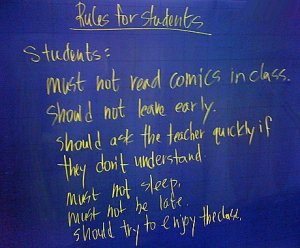What Do Your Rules Say About You?
Rules, rules, rules. Everyone knows the key to success in school is to follow the rules.
Unfortunately, this belief persists in many of today's classrooms and schools. Next time you are in a classroom, take a look at the posted rules. Maybe they're rules such as, "No talking while the teacher is talking. Stay in your desk during work time. Raise your hand if you need help." If so, I think these rules say a lot about the teacher, the work environment and the level of meaningful, engaging tasks. They imply that the teacher is the only one who holds the knowledge, that the teacher will give you great wisdom only if you will listen and only if the work you undertake will be solitary and designed to measure how well you listen.

Why is it that some classrooms need these types of rules and some do not? For the teachers that do not post such rules, what is the difference? How can they manage without them?
One answer to these questions is to take a look at the type of tasks the student is being asked to undertake, to analyze the planning and preparation the teacher has given to design tasks which result in high levels of student engagement.
Think of it this way. If a teacher designs tasks that engage the student in meaningful learning, will the student be wandering around the classroom off task, disrupting others, and doing any of the other million things teachers often complain about?
But just what goes into meaningful learning and task design that results in high levels of student engagement?
Q&A About Student Engagement
I would like to give credit to the amazing staff at Erin Woods School in Calgary, AB who worked together yesterday to answer this question. When analyzing student engagement and tasks that result in high levels of student engagement, we were able to effectively answer this question: "What are the attributes of tasks that result in meaningful learning and high(er) levels of student engagement?"
Tasks resulting in higher levels of student engagement consist of these attributes:
- Meaningful or related to the student's life or interests
- Working together with peers
- Incorporates games
- Created by the student (and therefore more authentic)
- Resulting in a piece of work the student is proud of and wants to share
- Challenging -- but not so challenging it is unattainable
- Considers different learning styles
- Allows for student choice
- Can be extended by students
Tasks resulting in lower levels of student engagement consist of these attributes:
- Easy and quick to complete (requires low levels of thinking)
- Teacher designed (such as a worksheet)
- Results in right or wrong answers
- Considers none or all of the attributes of high engaging tasks.
When considering student engagement and the types of tasks they're asked to complete, I wonder whether students given tasks designed to be highly meaningful and engaging really need their teachers to post rules such as "stay in your desk during work time." Do these rules imply that you have just entered a classroom of low-engaging task design? In my opinion, teachers who strive to design meaningful tasks that engage students are more likely to post rules such as "Work hard and do your best" or "Respect yourself and others" on the walls of their classroom.